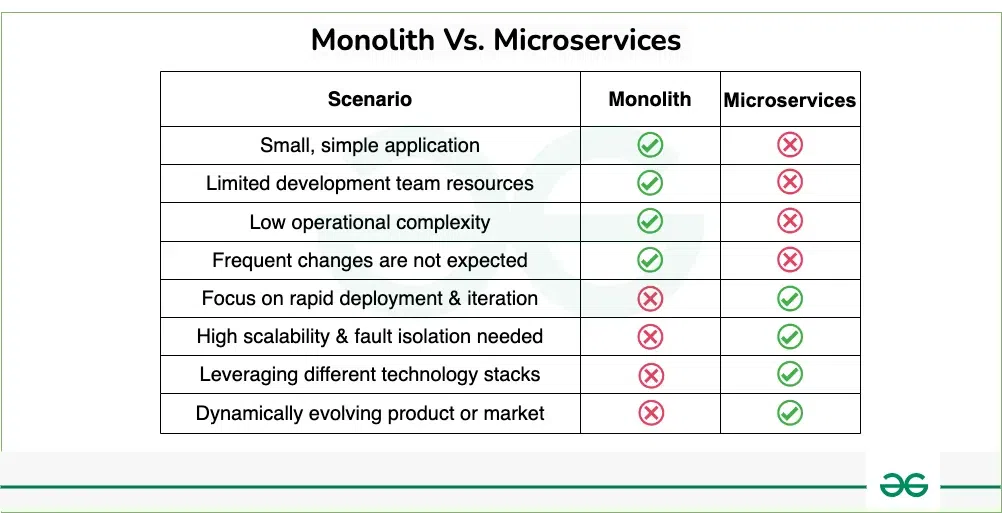Monolithic vs. Microservices Architecture
Last Updated :
03 Jan, 2025
In software development, how you structure your application can have a big impact on how it works and how easy it is to manage. Two common ways to structure software are called monolithic and microservices architectures. In this article, we'll explore the differences between these two approaches and when you might choose one over the other.

Software is traditionally designed using a monolithic architecture, in which the entire program is constructed as a single, indivisible unit. Every component of the program, including the data access layer, business logic, and user interface, is deployed and integrated tightly together in this design.
- This means that any changes or updates to the application require modifying and redeploying the entire monolith.
- Monolithic architectures are often characterized by their simplicity and ease of development, especially for small to medium-sized applications.
- However, they can become complex and difficult to maintain as the size and complexity of the application grow.

A microservices architecture results in an application designed as a set of small, independent services. Each one represents a business capability in itself. The services loosely couple with one another and communicate over the network, typically making use of lightweight protocols such as HTTP or messaging queues.
- Each service is responsible for a single functionality or feature of the application and can be developed, deployed, and scaled independently.
- The Microservice architecture has a significant impact on the relationship between the application and the database.

Differences between Monolithic and Microservices Architecture
Below are the differences the Monolithic and Microservice architecture:
| Aspect | Monolithic Architecture | Microservice Architecture |
|---|
| Architecture | Single-tier architecture | Multi-tier architecture |
|---|
| Size | Large, all components tightly coupled | Small, loosely coupled components |
|---|
| Deployment | Deployed as a single unit | Individual services can be deployed independently |
|---|
| Scalability | Horizontal scaling can be challenging | Easier to scale horizontally |
|---|
| Development | Development is simpler initially | Complex due to managing multiple services |
|---|
| Technology | Limited technology choices | Freedom to choose the best technology for each service |
|---|
| Fault Tolerance | Entire application may fail if a part fails | Individual services can fail without affecting others |
|---|
| Maintenance | Easier to maintain due to its simplicity | Requires more effort to manage multiple services |
|---|
| Flexibility | Less flexible as all components are tightly coupled | More flexible as components can be developed, deployed, and scaled independently |
|---|
| Communication | Communication between components is faster | Communication may be slower due to network calls |
|---|
Best Scenarios for Monolithic and Microservices Architecture
Below are the best scenarios where we can use Monolithic Architecture or Microservices Architecture:

Conclusion
In Conclusion, if you're building a small project, a monolithic architecture is like having everything in one big box, which can be easier to manage at first. However, as the project gets bigger, it's like trying to fit more and more things into that same box, which can become difficult. On the other hand, with a microservices architecture, you have different smaller boxes, each handling a specific part of your project. This makes it easier to manage and scale as your project grows, but it requires more planning and coordination to make sure all the boxes work together smoothly.
Similar Reads
Monolithic vs. Service-Oriented vs. Microservice Architecture This article explores the differences between monolithic, service-oriented, and microservices architectures. Each architecture offers distinct benefits and challenges, influencing how applications are developed, deployed, and maintained.Monolithic vs. Service-Oriented vs. Microservice ArchitectureTa
4 min read
Monolithic Architecture in OS The monolithic operating system is a very simple operating system where the kernel directly controls device management, memory management, file management, and process management. All of the system's resources are accessible to the kernel. Every part of the operating system is contained within the k
7 min read
Steps to Migrate From Monolithic to Microservices Architecture Moving from one big block of software to many smaller blocks might seem hard, but it's worth it. In this article, we'll show you how to do it step by step. We'll break down the big blocks into smaller ones, making your software more flexible and strong. It's like upgrading from a bulky car to a slee
5 min read
Websockets in Microservices Architecture WebSockets play a crucial role in microservices architecture by enabling real-time, bidirectional communication between services and clients. Unlike traditional HTTP protocols, WebSockets maintain a persistent connection, allowing for low-latency, efficient data exchange. This makes them ideal for a
11 min read
MVC Architecture vs. Microservices Architecture In the world of system design, choosing the right architecture for your project is crucial. Two prominent contenders are Microservices and Model-View-Controller (MVC). While both offer distinct advantages, understanding their core differences is essential for making an informed decision. Important T
3 min read